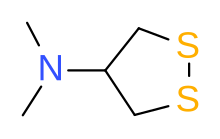
| |
| Names | |
|---|---|
| Preferred IUPAC name
N,N-Dimethyl-1,2-dithiolan-4-amine | |
| Other names
NTX
| |
| Identifiers | |
| |
3D model (JSmol)
|
|
| ChEBI |
|
| ChemSpider | |
| ECHA InfoCard | 100.121.136 |
| EC Number |
|
| KEGG | |
PubChem CID
|
|
| UNII |
|
CompTox Dashboard (EPA)
|
|
| |
| |
| Properties | |
| C5H11NS2 | |
| Molar mass | 149.27 g·mol−1 |
Except where otherwise noted, data are given for materials in their standard state (at 25 °C [77 °F], 100 kPa).
| |
Nereistoxin is a natural product identified in 1962 as the toxic organic compound N,N-dimethyl-1,2-dithiolan-4-amine. It had first been isolated in 1934 from the marine annelid Lumbriconereis heteropoda and acts by blocking the nicotinic acetylcholine receptor.[1] Researchers at Takeda in Japan investigated it as a possible insecticide. They subsequently developed a number of derivatives that were commercialised,[2][3] including those with the ISO common names[4] bensultap,[5] cartap,[6] thiocyclam[7] and thiosultap.[8][9]
- ^ Teuber, Lene (1990). "Naturally Occurring 1,2-Dithiolanes and 1,2,3-Trithianes. Chemical and Biological Properties". Sulfur Reports. 9 (4): 257–333. doi:10.1080/01961779008048732.
- ^ Roberts, Terry R; Hutson, David H, eds. (2007). "Nereistoxin precursors". Metabolic Pathways of Agrochemicals. pp. 127–138. doi:10.1039/9781847551375-00127. ISBN 978-0-85404-499-3.
- ^ Lewis, Kathleen A.; Tzilivakis, John; Warner, Douglas J.; Green, Andrew (2016). "An international database for pesticide risk assessments and management". Human and Ecological Risk Assessment. 22 (4): 1050–1064. Bibcode:2016HERA...22.1050L. doi:10.1080/10807039.2015.1133242. hdl:2299/17565. S2CID 87599872.
- ^ "Compendium of Pesticide Common Names". BCPC.
- ^ Pesticide Properties Database. "Bensultap". University of Hertfordshire.
- ^ Pesticide Properties Database. "Cartap". University of Hertfordshire.
- ^ Pesticide Properties Database. "Thiocyclam". University of Hertfordshire.
- ^ Pesticide Properties Database. "Thiosultap". University of Hertfordshire.
- ^ Konishi, Kazuo (1968). "New Insecticidally Active Derivatives of Nereistoxin". Agricultural and Biological Chemistry. 32 (5): 678–679. doi:10.1271/bbb1961.32.678.